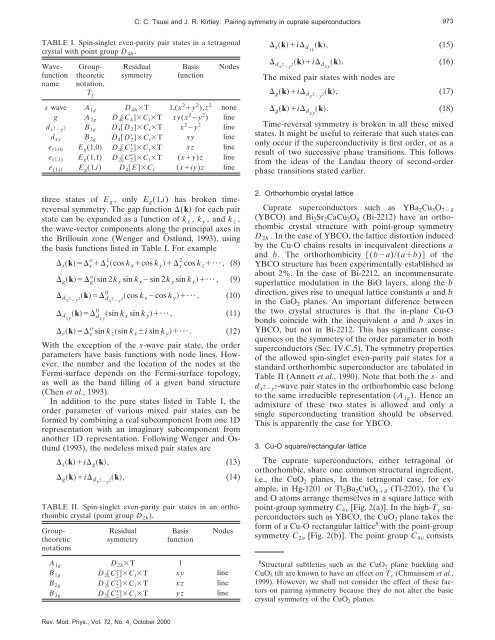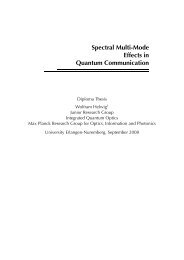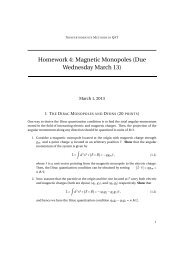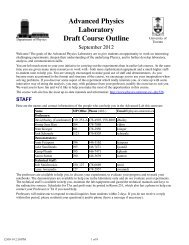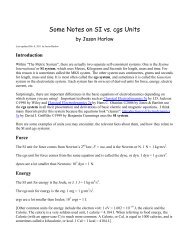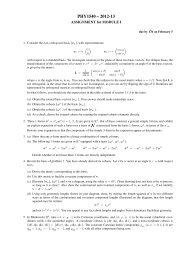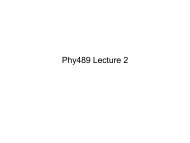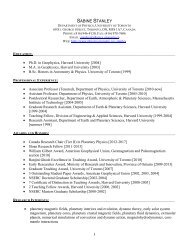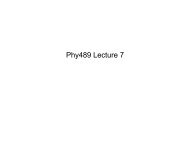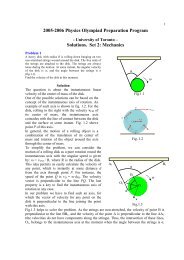Kirtley and Tsuei - Physics
Kirtley and Tsuei - Physics
Kirtley and Tsuei - Physics
Create successful ePaper yourself
Turn your PDF publications into a flip-book with our unique Google optimized e-Paper software.
C. C. <strong>Tsuei</strong> <strong>and</strong> J. R. <strong>Kirtley</strong>: Pairing symmetry in cuprate superconductors<br />
973<br />
TABLE I. Spin-singlet even-parity pair states in a tetragonal<br />
crystal with point group D 4h .<br />
Wavefunction<br />
name<br />
Grouptheoretic<br />
notation,<br />
T j<br />
Residual<br />
symmetry<br />
Basis<br />
function<br />
Nodes<br />
s wave A 1g D 4h T 1,(x 2 y 2 ),z 2 none<br />
g A 2g D 4 C 4 C i T xy(x 2 y 2 ) line<br />
d x 2 y 2 B 1g D 4 D 2 C i T x 2 y 2 line<br />
d xy B 2g D 4 D 2 C i T xy line<br />
e (1,0) E g (1,0) D 4 C 2 C i T xz line<br />
e (1,1) E g (1,1) D 2 C 2 C i T (xy)z line<br />
e (1,i) E g (1,i) D 4 EC i (xiy)z line<br />
three states of E g , only E g (1,i) has broken timereversal<br />
symmetry. The gap function (k) for each pair<br />
state can be exp<strong>and</strong>ed as a function of k x , k y , <strong>and</strong> k z ,<br />
the wave-vector components along the principal axes in<br />
the Brillouin zone (Wenger <strong>and</strong> Östlund, 1993), using<br />
the basis functions listed in Table I. For example<br />
s k s o s 1 cos k x cos k y s 2 cos k z ¯ , (8)<br />
g k g o sin 2k x sin k y sin 2k y sin k x ¯ , (9)<br />
0<br />
dx k 2 y 2 dx cos k 2 y 2 x cos k y ¯ , (10)<br />
0<br />
dxy k dxy sin k x sin k y ¯ , (11)<br />
e k o e sin k z sin k x i sin k y ¯ . (12)<br />
With the exception of the s-wave pair state, the order<br />
parameters have basis functions with node lines. However,<br />
the number <strong>and</strong> the location of the nodes at the<br />
Fermi-surface depends on the Fermi-surface topology,<br />
as well as the b<strong>and</strong> filling of a given b<strong>and</strong> structure<br />
(Chen et al., 1993).<br />
In addition to the pure states listed in Table I, the<br />
order parameter of various mixed pair states can be<br />
formed by combining a real subcomponent from one 1D<br />
representation with an imaginary subcomponent from<br />
another 1D representation. Following Wenger <strong>and</strong> Östlund<br />
(1993), the nodeless mixed pair states are<br />
s ki g k, (13)<br />
g ki dx 2 y 2 k, (14)<br />
TABLE II. Spin-singlet even-parity pair states in an orthorhombic<br />
crystal (point group D 2h ).<br />
Grouptheoretic<br />
notations<br />
Residual<br />
symmetry<br />
Basis<br />
function<br />
Nodes<br />
A 1g D 2h T 1<br />
B 1g D 2 C z 2 C i T xy line<br />
B 2g D 2 C y 2 C i T xz line<br />
B 3g D 2 C x 2 C i T yz line<br />
s ki dxy k, (15)<br />
dx 2 y 2 ki dxy k. (16)<br />
The mixed pair states with nodes are<br />
g ki dx k, (17)<br />
2 y 2<br />
g ki dxy k. (18)<br />
Time-reversal symmetry is broken in all these mixed<br />
states. It might be useful to reiterate that such states can<br />
only occur if the superconductivity is first order, or as a<br />
result of two successive phase transitions. This follows<br />
from the ideas of the L<strong>and</strong>au theory of second-order<br />
phase transitions stated earlier.<br />
2. Orthorhombic crystal lattice<br />
Cuprate superconductors such as YBa 2 Cu 3 O 7<br />
(YBCO) <strong>and</strong> Bi 2 Sr 2 CaCu 2 O 8 (Bi-2212) have an orthorhombic<br />
crystal structure with point-group symmetry<br />
D 2h . In the case of YBCO, the lattice distortion induced<br />
by the Cu-O chains results in inequivalent directions a<br />
<strong>and</strong> b. The orthorhombicity (ba)/(ab) of the<br />
YBCO structure has been experimentally established as<br />
about 2%. In the case of Bi-2212, an incommensurate<br />
superlattice modulation in the BiO layers, along the b<br />
direction, gives rise to unequal lattice constants a <strong>and</strong> b<br />
in the CuO 2 planes. An important difference between<br />
the two crystal structures is that the in-plane Cu-O<br />
bonds coincide with the inequivalent a <strong>and</strong> b axes in<br />
YBCO, but not in Bi-2212. This has significant consequences<br />
on the symmetry of the order parameter in both<br />
superconductors (Sec. IV.C.5). The symmetry properties<br />
of the allowed spin-singlet even-parity pair states for a<br />
st<strong>and</strong>ard orthorhombic superconductor are tabulated in<br />
Table II (Annett et al., 1990). Note that both the s- <strong>and</strong><br />
d x 2 y2-wave pair states in the orthorhombic case belong<br />
to the same irreducible representation (A 1g ). Hence an<br />
admixture of these two states is allowed <strong>and</strong> only a<br />
single superconducting transition should be observed.<br />
This is apparently the case for YBCO.<br />
3. Cu-O square/rectangular lattice<br />
The cuprate superconductors, either tetragonal or<br />
orthorhombic, share one common structural ingredient,<br />
i.e., the CuO 2 planes. In the tetragonal case, for example,<br />
in Hg-1201 or Tl 2 Ba 2 CuO 6 (Tl-2201), the Cu<br />
<strong>and</strong> O atoms arrange themselves in a square lattice with<br />
point-group symmetry C 4 [Fig. 2(a)]. In the high-T c superconductors<br />
such as YBCO, the CuO 2 plane takes the<br />
form of a Cu-O rectangular lattice 8 with the point-group<br />
symmetry C 2 [Fig. 2(b)]. The point group C 4 consists<br />
8 Structural subtleties such as the CuO 2 plane buckling <strong>and</strong><br />
CuO 5 tilt are known to have an effect on T c (Chmaissem et al.,<br />
1999). However, we shall not consider the effect of these factors<br />
on pairing symmetry because they do not alter the basic<br />
crystal symmetry of the CuO 2 planes.<br />
Rev. Mod. Phys., Vol. 72, No. 4, October 2000


